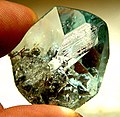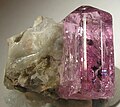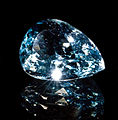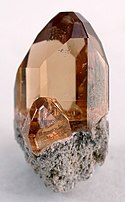Topaz
(c) Rob Lavinsky, iRocks.com – CC-BY-SA-3.0 | |
| Właściwości chemiczne i fizyczne | |
| Skład chemiczny | Al2SiO4(OH, F)2 – zasadowy fluorokrzemian glinu |
|---|---|
| Twardość w skali Mohsa | 8 |
| Przełam | muszlowy |
| Łupliwość | doskonała ({001}) |
| Pokrój kryształu | długie, do krótkich pryzmatycznych |
| Układ krystalograficzny | rombowy, mmm (2/m 2/m 2/m) |
| Gęstość minerału | 3,4 do 3,6 g/cm³ |
| Właściwości optyczne | |
| Barwa | bezbarwny (gdy brak zanieczyszczeń innymi metalami), niebieski, brązowy, pomarańczowy, żółty, zielony, różowy, malinowy |
| Rysa | biała |
| Połysk | szklisty |
| Współczynnik załamania | nα = 1,606–1,629 |
| Inne | dwójłomność δ = 0,010 |
Topaz – minerał z gromady krzemianów, rozpowszechniony w wielu rejonach świata.
Nazwa pochodzi od gr. τοπάζιος (topázios) = poszukiwać lub od sanskryckiego słowa topas = ogień, co nawiązuje do pomarańczowo-złotej barwy i blasku szlachetnych odmian tego minerału[1][2].
Właściwości
Tworzy kryształy słupkowe, niemal izometryczne, także beczułkowate (znanych jest ok. 150 różnych jego postaci). Występuje w skupieniach zbitych, ziarnistych słupkowych i pręcikowych. Jest kruchy i przezroczysty, charakteryzuje się ogromnym bogactwem barw.
W zależności od zabarwienia, wykształcenia i pochodzenia bywa określany różnymi nazwami regionalnymi, zwyczajowymi, handlowymi i gemmologicznymi: t. sherry, hiacynt, t. imperial, t. szlachetny, t. syberyjski, t. safiras, t. royal, t. Peredell, t. taurydzki, szafir brazylijski, szafir wodny, rubin brazylijski, diament niewolników, pyknit. Często zawiera domieszki żelaza, chromu, wanadu, tytanu. Okazy niebieskie i żółtopomarańczowe wykazują niekiedy efekt kociego oka.
Występowanie
Występuje w kwaśnych skałach magmowych: granitach, pegmatytach, w skałach kontaktowych: grejzenach. Współwystępuje z turmalinem, kasyterytem, fluorytem, muskowitem[3].
Miejsca występowania to głównie: Brazylia – Minas Gerais (kryształy kilkudziesięciocentymetrowe o wadze 150–300 kg: największy okaz znaleziono w 1986 r. mierzył 2x1,8 m i ważył 5 ton), Sri Lanka, Pakistan, Ural, Nigeria i Madagaskar, Mozambik (znaleziono kryształ o długości 1 m i wadze 2,5 t), Indie, Japonia, Rosja, Czechy, Niemcy, Norwegia (żółty kryształ o wadze 80 kg), Ukraina.
W Polsce występuje w Górach Izerskich, Karkonoszach oraz okolicach Strzegomia i Strzelina.
Zastosowanie
- Jest stosowany przy produkcji materiałów ogniotrwałych i ściernych
- bardzo atrakcyjny kamień kolekcjonerski
- stosowany w jubilerstwie – stosuje się szlif fasetkowy.
- (c) Rob Lavinsky, iRocks.com – CC-BY-SA-3.0
- (c) Rob Lavinsky, iRocks.com – CC-BY-SA-3.0
- (c) Rob Lavinsky, iRocks.com – CC-BY-SA-3.0
- (c) Rob Lavinsky, iRocks.com – CC-BY-SA-3.0
- (c) Rob Lavinsky, iRocks.com – CC-BY-SA-3.0
- (c) Rob Lavinsky, iRocks.com – CC-BY-SA-3.0
Przypisy
- ↑ Żaba J., 2014: Ilustrowana encyklopedia skał i minerałów. Videograf.
- ↑ Online Etymology Dictionary: topaz.
- ↑ mindat.org Topaz (ang.) [dostęp 2011-05-31].
Media użyte na tej stronie
(c) Rob Lavinsky, iRocks.com – CC-BY-SA-3.0
Topaz
- Locality: Kuza, Jos Plateau, Plateau State, Nigeria (Locality at mindat.org)
- The camera reflected back the natural imperfections towards the bottom of this specimen too much. In person, it is intensely gemmy for the most part, and the fracturing in internal and does not detract nearly as much as the photos indicate. In fact, you could cut a remarkable stone from the top of this crystal. But, you would not want to, because the termination and faces are just textbook and superb. The luster and gemminess are just tops, and remember this is NOT from Brazil but NIGERIA! 2.8 x 2.6 x 1.4 cm
Autor: Captmondo, Licencja: CC BY-SA 3.0
117 kg topaz, originally from Brazil, on display at the Naturhistorisches Museum, Vienna
(c) Rob Lavinsky, iRocks.com – CC-BY-SA-3.0
Topaz
- Locality: Itinga, Jequitinhonha valley, Minas Gerais, Southeast Region, Brazil (Locality at mindat.org)
- Size: 9.2 x 5.3 x 4.9 cm.
- A huge GEM topaz crystal with NATURAL light blue color, from Itinga. This whopper weighs in at 423 grams, and ALL of it is gemmy! What is more, the crystal is DOUBLY-TERMINATED (with complex faces and subcrystals on the bottom). There are a few areas of natural contact where the crystal grew against matrix. There are pretty striations on the vertical faces.
(c) Rob Lavinsky, iRocks.com – CC-BY-SA-3.0
Topaz
- Locality: Tepetate, Municipio de Villa de Arriaga, San Luis Potosí, Mexico (Locality at mindat.org)
- A super thumber of GEMMY topaz crystals, growing in all directions! The cluster is complete and undamaged all the way around. Rare in such quality, for the size! Most thumbs are just plain singles…. 3.0 x 2.3 x 2.1cm
Autor: Michelle Jo, Licencja: CC BY 3.0
Genuine topaz gemstones in various colours. mystic and azotic topaz is also seen.
Autor: MBisanz, Licencja: CC BY-SA 3.0
Topaz - Exposed in the National Museum of Natural History (look also on the website of the National Museum of Natural History, Smithsonian Institution)
- Original text on the sign: Topaz - 50,4 kg (111 lb) and 31,8 kg (70 lb) - Minas Gerais, Brazil
- These are two of the finest larg topaz crystals. Before arriving here, they where slated to be cut up for use in scientific instruments. What look like bubbles rising inside are imprints of albite crystals that once grew against the back surfaces.
- Gift of Howard G. Freeman and Joseph M. Linsey, 1981
- Catalog Number: 148089, 148090
(c) Rob Lavinsky, iRocks.com – CC-BY-SA-3.0
Topaz
- Locality: Catamarca, Argentina (Locality at mindat.org)
- Size: 3.4 x 2.7 x 2.5 cm.
- A rather rare ARGENTINE topaz crystal, attractively accented with smoky quartz. The crystal is complete all around, with a good termination and striated side faces. The interior is quite gemmy.
(c) Rob Lavinsky, iRocks.com – CC-BY-SA-3.0
Topaz
- Locality: Itinga, Jequitinhonha valley, Minas Gerais, Southeast Region, Brazil (Locality at mindat.org)
- Size: 6.1 x 5.3 x 5.0 cm.
- A complete-all-around, glassy crystal that is as good as you can get for lustre and flash from these new finds (at least in this size and price range, I can say that it is the best combination of these traits I have seen out of hundreds of crystals the last 2 years). The piece has internal veils, as do most, but it is decidedly free of the usual etching that occurs to some degree and in particular has a surprisingly fine and broad termination.
(c) Rob Lavinsky, iRocks.com – CC-BY-SA-3.0
Topaz
- Locality: Katlang, Mardan District, North-West Frontier Province, Pakistan (Locality at mindat.org)
- This is really quite an amazing Purple Topaz thumbnail from the famous and rather small despoit in Katlang which has produced the only topaz of such color in the Himalayas. They are extremely rare, and good aesthetic specimens are hard to find...matrix specimens even harder still. The luster is superb, it is gemmy, the color is a beautiful rich purple-lavender hue, and it sits so perfectly on matrix. 2 x 1.8 x 1.6 cm This Photo was Mindat.org Photo of the Day - 20th Oct 2006
(c) Rob Lavinsky, iRocks.com – CC-BY-SA-3.0
Topaz
- Locality: Maynard's Claim (Pismire Knolls), Thomas Range, Juab County, Utah, USA (Locality at mindat.org)
- What a gem! This complete, absolutely gorgeous crystal is the perfect thumbnail ....a fat gem perched on a natural display pedestal. These crystals Charlie had put away back in the 1960s after a good trade with dealer A.L. McGuiness GLOW with color and are, for combination of color and clarity, the finest I have seen for sale. This SUPER THUMBNAIL is so clean that it squeaks! 2.4 x 1.7 x 1.3 cm
Autor: Didier Descouens, Licencja: CC BY-SA 4.0
Topaz cut - Xanda Mine, Virgem da Lapa, Araçuaí Pegmatite District, Eastern Brazilian Pegmatite Province, Minas Gerais, Southeast Region, Brazil (3.2x2.2cm)
(c) Rob Lavinsky, iRocks.com – CC-BY-SA-3.0
Topaz
- Locality: Erongo Mountain, Usakos and Omaruru Districts, Erongo Region, Namibia (Locality at mindat.org)
- NOTE THIS IS topaz of a slight blue color, and thats nice enough, and its extremely aesthetic and impressive and gemmy on its own merits....but it is ERONGO and not from the more common and assumed best Namib topaz locality of Spitzkopje! This took me by surprise. I had not seen such fine Erongo topaz before! And, its much MUCH better in person. The pleasant pastel blue color it has, does not show well in photos here. 9.6 x 6.5 x 4.8 cm























